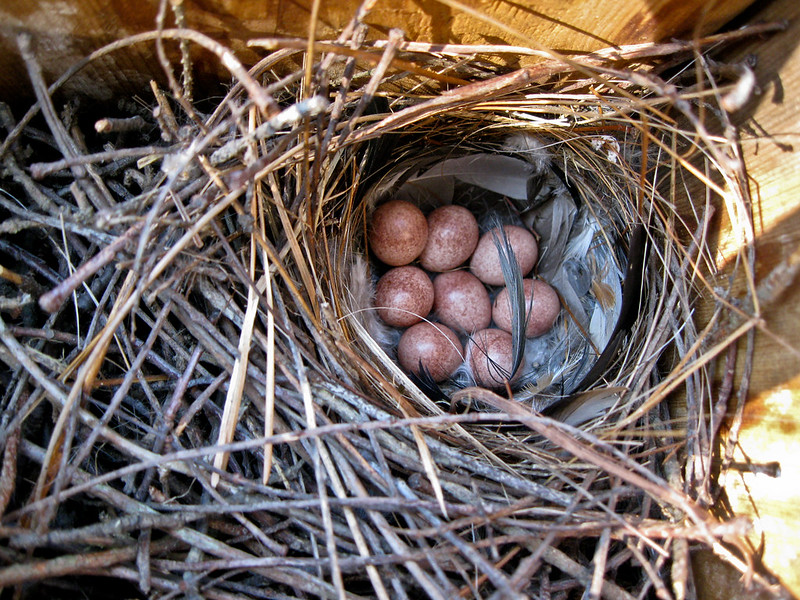By Chelsea Jandreau
At Audubon, we have been taking students out on the trails for the last few weeks. My group often ends up in a line of spruce trees, and underneath the trees the kids have discovered a spread of broken blue eggshells.
When the kids started asking questions about those particular blue eggshells, they wanted to know where they came from, why the eggs were blue and why they were so spread out. However, in all of their questions, there was never a doubt that these eggs came from birds. What bird laid these eggs? Where are the birds now? Is there a bird nest in the trees?

We are well into the season of eggs and baby animals. A couple of nest boxes that once had House Wren eggs are now empty, but swallows are flying in and out of nest boxes on the pond’s edge. The goslings are steadily getting bigger and growing their adult feathers. As spring turns into summer, many birds have already made their nests and laid their eggs. Some of those eggs have successfully hatched, while others ended up a meal for another animal. Week to week, students have come to Audubon and watched the progression of nest building, egg laying, hatchlings and so on.
Animals that lay eggs are called oviparous. The prefix “ovo-” refers to eggs and “-parous” refers to producing offspring. Despite the strong association of eggs with birds, they are far from the only animals to lay eggs. Egg laying is incredibly common. In fact, most animals that are viviparous, or give birth to live young instead of laying eggs, are mammals, and even they have a couple exceptions in the egg-laying platypus and echidna.
Most birds, reptiles and amphibians lay eggs, but so do many fish, insects, slugs, spiders and worms. These eggs vary in size, shape, color, hardness and texture depending on the animal. Many frogs and salamander eggs come in squishy masses in ponds and vernal pools rather than the hard shells found in the land-based nests of birds and turtles. Insects and other invertebrates lay impossibly tiny eggs on the underside of leaves and buried in leaf litter on the ground.
When it comes to the myriad of ways baby animals enter the world, there is no one best way to go about it. Each method has its own pros and cons and animals have evolved to use the method that works best in their environment. Some methods require less energy, some spend longer with their young to give them better odds of survival and some just lay a whole bunch of eggs with the expectation that many of them are not going to make it to adulthood.
With so many different animals across the world laying eggs, there are bound to be some differences in the execution. If you dig even deeper into those strategies and differences, there is also something of a middle ground when it comes to egg laying versus live birth. Garter snakes, a few other snakes, sharks and some frogs are here to provide you with your weird wildlife word of the week: ovoviviparity. It looks made up, I know, but if you look at the word a little longer, you will notice that it is a combination of egg laying, “ovo-”, and live birth, “vivi-”.
These animals do technically lay eggs, but the eggs remain inside their body until they are ready to hatch. Basically, instead of creating a nest or other safe space to lay their eggs, that safe space is inside of the mother. There is no placenta or transfer of nutrients as there would be with a viviparous animal, but the eggs are both protected from the elements and kept at a warm enough temperature to survive.

If you see a snake somewhere around western NY or PA, it might be a Garter Snake. Garter Snakes are one of those ovoviviparous animals. They produce eggs similar to other snake eggs and the embryos develop inside the egg, but instead of being buried or put in a nest, they remain inside the mother. They hatch inside the adult and then the snake appears to give birth to live babies.
As with many words, the definition can get a bit muddled along the way. So another phrase that some use to define this in-between stage is ‘prolonged egg retention.’ This also makes sense. The eggs are simply retained inside the body for longer than the average egg-laying animal. And if you really want to go down the rabbit hole, there are plenty of other nuances to be found among egg-laying animals.
Nature has many different ways to accomplish the same goal. No two types of eggs are exactly the same, and there are just as many methods parents use to keep those eggs as safe as possible. As spring explorations turn into summer outside adventures, keep an eye out for eggs in the trees, on the ground, and in the water and see what you notice.
Audubon Community Nature Center builds and nurtures connections between people and nature. ACNC is located just east of Route 62 between Warren and Jamestown. The trails are open from dawn to dusk as is Liberty, the Bald Eagle. The Nature Center is open from 10 a.m. until 4:30 p.m. daily except Sunday when it opens at 1 p.m. More information can be found online at auduboncnc.org or by calling (716) 569-2345.
Chelsea Jandreau is a Nature Educator at Audubon Community Nature Center.


Recent Comments